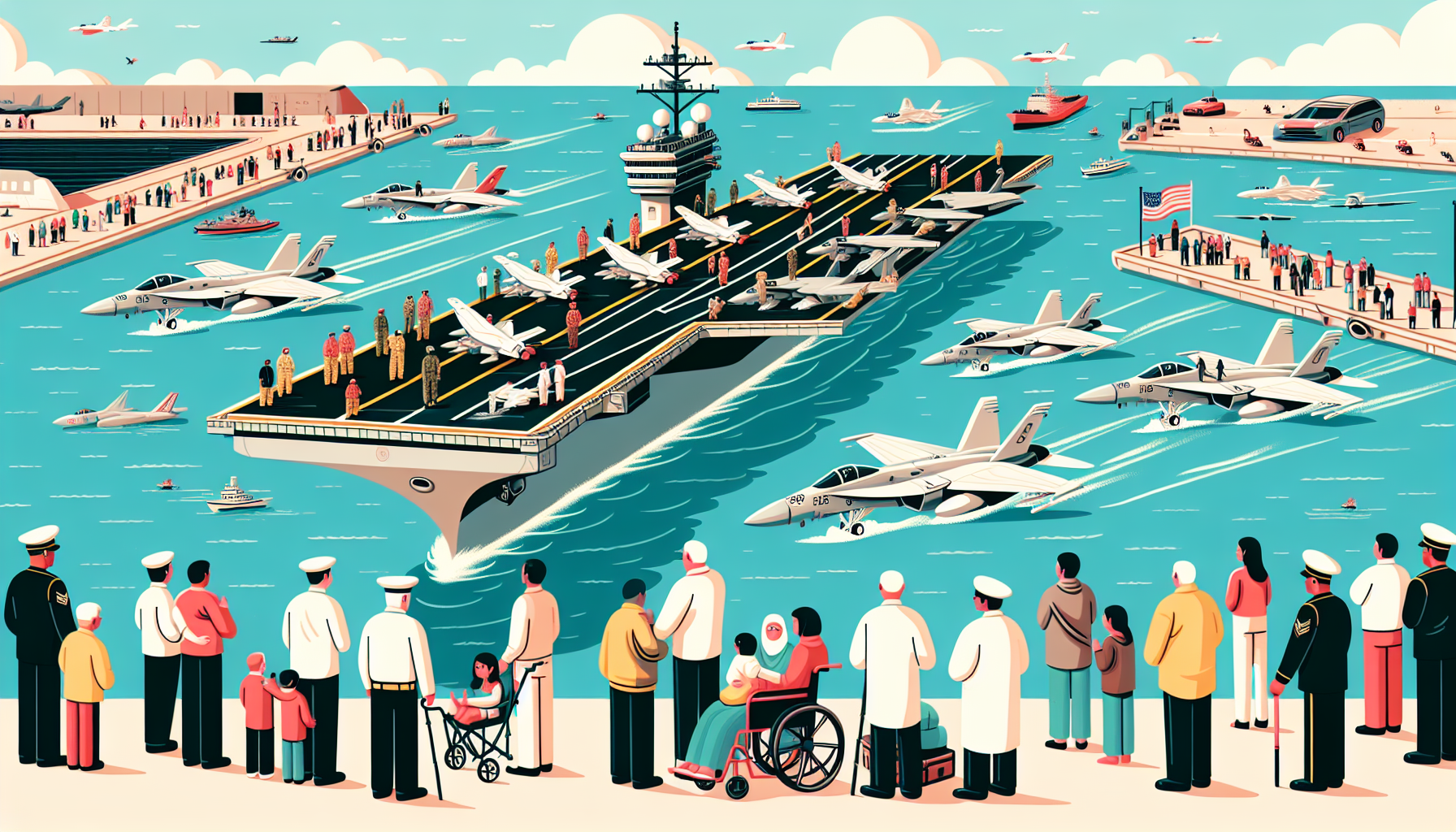Definition
A Carrier Air Wing (CVW) is a term used to describe an operational unit of the United States Navy, consisting of multiple aircraft squadrons. The main purpose of a CVW is to provide tactical air support in both offensive and defensive missions, while being deployed on an aircraft carrier. Each CVW typically includes a mix of various types of aircraft, such as fighter jets, electronic warfare planes, and airborne early warning aircraft, among others.
Key Takeaways
- A Carrier Air Wing (CVW) is an operational naval aviation organization composed of several aircraft squadrons and detachments. It provides striking power, electronic warfare, and air support for naval operations.
- CVWs operate from aircraft carriers as a team, providing the carrier with various attack and defense capabilities. The composition of a CVW typically includes fighter, attack, and electronic warfare aircraft, as well as helicopters for anti-submarine warfare and search-and-rescue missions.
- Each CVW is attached to an individual aircraft carrier and supports the carrier’s mission by providing air superiority, reconnaissance, and close air support to ground forces, as well as aerial refueling and logistics support.
Importance
The term Carrier Air Wing (CVW) holds significant importance in military operations as it represents a fundamental operational unit of naval aviation.
CVWs consist of several aircraft squadrons, each specialized in various combat missions, working together to enhance the combat effectiveness and power projection capabilities of a naval fleet.
By operating from aircraft carriers, CVWs provide an unparalleled degree of flexibility, mobility, and adaptability, enabling rapid response to diverse threats and support for ground forces across the globe.
The integration of various aircraft types, ranging from fighter jets to helicopters, in a CVW ensures optimal utilization of combined assets, allowing it to facilitate a broad spectrum of military operations such as air superiority, strike, reconnaissance, electronic warfare, and logistical support.
Overall, the Carrier Air Wing embodies a vital component of modern naval warfare, bolstering the strength and strategic reach of a country’s armed forces.
Explanation
A carrier air wing (CVW) serves as a critical component within naval military operations, designed to enhance the offensive and defensive capabilities of an aircraft carrier strike group. The primary purpose of a CVW is to project air power and provide aerial support for maritime operations, enabling countries to assert control over their territorial and international waters effectively.
Comprised of various fixed-wing aircraft and rotary-wing helicopters, CVWs are highly versatile and efficient in facing multiple threats from air, surface, and sub-surface targets. As such, they play an integral role in maintaining a robust naval presence and are often employed in various operations, including reconnaissance, air defense, ground attack, and anti-submarine warfare.
Furthermore, CVWs contribute significantly to the flexibility and adaptability of deployed naval forces. By endowing aircraft carriers with unparalleled combat capabilities, they allow naval commanders to engage adversaries across various fronts and promptly respond to evolving threats or emerging contingencies.
This multifaceted nature makes CVWs an indispensable asset in modern naval warfare, where the ability to maneuver quickly and decisively can prove advantageous on the battlefield. In addition, CVWs work in tandem with surface combatants and support vessels within their strike group to maintain a strong, seamless defense, ensuring the protection of strategic maritime interests and preserving freedom of navigation for both commercial and military vessels.
Examples of Carrier air wing (CVW)
CVW-5: USS Ronald Reagan (CVN-76)Carrier Air Wing 5 (CVW-5) is a United States Navy aircraft carrier air wing stationed at Marine Corps Air Station Iwakuni, Japan. CVW-5 is currently assigned to the USS Ronald Reagan, a Nimitz-class nuclear-powered aircraft carrier. The air wing comprises various squadrons of aircraft, including fighter jets such as the F/A-18E/F Super Hornet, electronic attack aircraft like the EA-18G Growler, and support aircraft such as the E-2D Hawkeye and C-2A Greyhound.
CVW-17: USS George H.W. Bush (CVN-77)Carrier Air Wing 17 (CVW-17) is a United States Navy aircraft carrier air wing based at the Naval Air Station Oceana, Virginia. The air wing is currently attached to the USS George H.W. Bush, another Nimitz-class nuclear-powered aircraft carrier. The air wing consists of nine aircraft squadrons, flying a mix of fighter jets, electronic warfare aircraft, airborne early warning aircraft, and various support aircraft. Notable aircraft in this air wing include the F/A-18E/F Super Hornet, E-2 Hawkeye, and EA-18G Growler.
CVW-3: USS Dwight D. Eisenhower (CVN-69)Carrier Air Wing 3 (CVW-3) is a United States Navy aircraft carrier air wing based at Naval Air Station Oceana, Virginia. CVW-3 is assigned to the USS Dwight D. Eisenhower, a Nimitz-class nuclear-powered aircraft carrier. The air wing is composed of multiple aircraft squadrons, with a diverse range of capabilities, including fighter jets such as the F/A-18E/F Super Hornet, electronic attack aircraft like the EA-18G Growler, and support aircraft such as the E-2C Hawkeye and C-2A Greyhound.
Carrier Air Wing (CVW) FAQ
What is a Carrier Air Wing (CVW)?
A Carrier Air Wing (CVW) is a tactical air force unit consisting of several squadrons of aircraft that operate together on an aircraft carrier. It is an essential part of the carrier strike group and provides air power, force projection, and air superiority in maritime operations.
What types of aircraft are commonly found in a CVW?
A modern CVW typically includes a combination of fixed-wing aircraft and helicopters designed for various roles. These may include fighter, attack, airborne early warning, electronic attack, transport, and anti-submarine warfare aircraft, among others.
How many aircraft are typically in a CVW?
The number of aircraft in a CVW can vary, but a typical U.S. Navy Carrier Air Wing usually consists of around 60-70 aircraft. This number may change depending on the type of carrier, mission requirements, and available resources.
What is the role of a CVW during maritime operations?
A CVW’s primary role during maritime operations is to provide air superiority and power projection. A CVW can perform various missions such as air defense, strike warfare, anti-submarine and surface warfare, reconnaissance, airborne command and control, and logistics support.
How are CVWs organized?
Carrier Air Wings are usually organized into squadrons based on their specific roles. For example, fighter squadrons are made up of fighter aircraft, while electronic attack squadrons consist of aircraft specialized in electronic warfare. Other squadrons may include airborne early warning aircraft, transport aircraft, and helicopters for various missions.
Related Military Operation Terms
- Aircraft Carrier (CV)
- Naval Aviation
- F/A-18 Super Hornet
- E-2C/D Hawkeye
- Carrier Strike Group (CSG)
Sources for More Information
- U.S. Navy Official Website
- Naval Technology
- Naval History and Heritage Command
- U.S. Department of Defense Official Website
 Benefits.com Advisors
Benefits.com Advisors
With expertise spanning local, state, and federal benefit programs, our team is dedicated to guiding individuals towards the perfect program tailored to their unique circumstances.
Rise to the top with Peak Benefits!
Join our Peak Benefits Newsletter for the latest news, resources, and offers on all things government benefits.





















